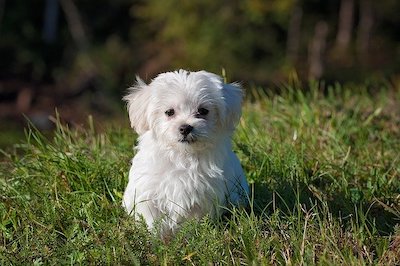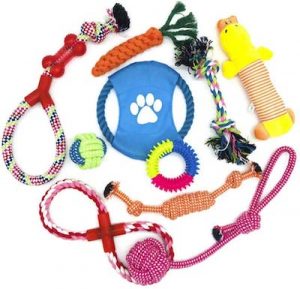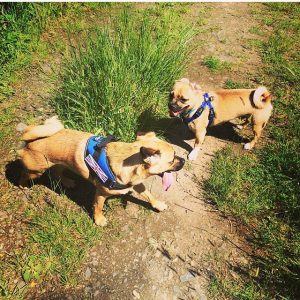Welcoming a new puppy into your home is an exciting and joyous experience. However, it’d be incredibly unfair to you if we ignore that their “high-energy” can quickly go from lively to annoying.
At 8 weeks old, puppies haven’t seen anything of the world, and their brains are now developed enough to understand basic things and have an insatiable curiosity.
More importantly, they don’t understand the concept of danger, nor do they understand their boundaries. To put it simply, they want to see everything. They don’t understand how to conserve energy properly and have not been trained outside of what their mother has done.
Some may see puppies as ‘naughty’, but perhaps that is unfair. They’re too young to understand right from wrong, making it impossible for them to be naughty, bad or evil.
Generally, most puppies start to calm down as they age. The “maturity age” differs based on breed, gender and size. For smaller puppies, it’s usually around 12 months, but larger breeds are more likely to occur between 18 months and 2 years.
Managing a puppy’s energy can be an exciting and rewarding endeavour when done in a certain way. So, I’ll give you some practical tips on how you can enjoy this phase instead.
So, let’s dive into the fascinating world of puppy development and discover when your adorable bundle of energy will eventually find its inner calmness.
When exactly do puppies calm down?
Your puppy will go through various developmental stages, and each stage has its unique characteristics. As a general guideline, you can expect puppies to start calming down as they reach adolescence, usually around six to twelve months of age.
While there are general trends in a puppy’s development, it’s important to remember that every puppy is unique. Just like humans, dogs have their personalities and temperaments.
Some puppies may naturally be calmer from an early age, while others may take longer to reach that point. As your puppy calms down, you may notice signs indicating its transition into a more composed state.
These signs include reduced hyperactivity, longer attention span, decreased destructive behaviour, and improved rest and sleep patterns.
What factors affect your puppy’s energy level?
A. Breed and Size Characteristics
Different breeds have been selectively bred for specific purposes, such as herding, hunting, or guarding. These purposes often require certain levels of energy and stamina. As a result, some breeds naturally have higher energy levels than others.
For example, working breeds like Border Collies and Australian Shepherds are known for their high energy and drive. In contrast, toy breeds like Chihuahuas or Pugs generally have lower energy levels and may require less exercise.
B. Exercise and Mental Stimulation
Physical activities, such as walks, playtime, and interactive games, help burn off excess energy and keep them physically fit. The amount and intensity of exercise needed will depend on your puppy’s age, breed, and overall health.
Moreover, their mental stimulation is equally important. Interactive toys, puzzle games, and training sessions can mentally stimulate and tire them out.
Pro Tip: Mental stimulation is especially valuable for breeds known for their intelligence, as it helps prevent boredom and the development of destructive behaviours.
C. Training and Socialization
Proper training helps them understand boundaries, manners, and appropriate behaviour, which can contribute to a calmer disposition. By teaching basic obedience commands and providing consistent guidance, you can help your puppy develop self-control and focus.
Socialisation, on the other hand, exposes puppies to various environments, people, and other animals. Investing time in training and socialisation from an early age sets the foundation for a well-behaved and balanced adult dog.
Read More: Free Feeding Vs Scheduled Feeding: Which Is Best For Dogs?
How does your puppy’s age affect their energy level?
A. From Birth to 10 Weeks
During the first ten weeks of a puppy’s life, its energy levels are generally high. They’ll have bursts of energy followed by deep sleep, and their play sessions can be intense.
However, their energy expenditure primarily focuses on building physical strength and motor skills. Providing a safe and stimulating environment for the puppies is important at this stage.
B. From 10 Weeks to 16 Weeks
Once your puppy enters the 10 to 16-week age range, their energy levels remain high, but they start to develop better coordination and endurance. They become more exploratory and may engage in active play, chasing toys or their canine companions.
Note: This is a crucial period for socialisation, and their energy is often directed toward learning and adapting to new experiences.
C. From 4 to 6 Months
Between four and six months of age, puppies typically experience a growth spurt. Their energy levels may fluctuate during this phase as they adjust to their changing bodies.
Your puppy will likely have bursts of high energy followed by periods of relaxation. Providing a balanced routine that includes physical exercise and mental stimulation is important.
D. From 6 to 12 Months
Adolescence happens during this phase. Their energy levels may peak during this time as they go through hormonal changes and continue to grow.
They may exhibit bursts of playful energy, but their overall energy may become more manageable compared to earlier stages.
E. From 1 to 2 Years
As puppies enter their second year of life, they typically mature into young adults. By this stage, their energy levels stabilise and become more settled.
They may still have moments of playful exuberance, but their overall energy may decrease compared to their earlier stages.
How to manage your puppy’s energy and keep calm?
A. Establish a routine for their day-to-day.
Dogs thrive on structure and predictability; having a routine helps them understand what is expected of them and provides stability.
Set regular times for meals, walks, playtime, training, and rest. This helps your puppy anticipate and expend their energy in a balanced manner throughout the day.
B. Provide appropriate outlets for their energy.
To prevent your puppy from becoming bored or restless, engage them in activities matching their breed, age, and individual preferences.
Interactive toys, such as puzzle feeders or treat-dispensing toys, can stimulate their minds while providing a physical challenge.
Set up playdates with other friendly dogs to encourage socialisation and allow your puppy to burn off excess energy in a safe and supervised environment.
C. Use positive reinforcement training techniques.
Training is the absolute key to calming a dog down quickly and effectively. No doubt about it.
It helps them understand their boundaries and what is acceptable and what it isn’t. Generally, people describe their dogs as hard work because they keep doing things they shouldn’t do. Therefore, teach them what they shouldn’t do and keep working on it until they get it.
This could take weeks, but during that time, they will gradually become more and more obedient – they will still be full of life and rambunctious, but they will do it safely and not overstep their mark as often.
If you do not train your dog, it may never calm down and become worse.
Positive reinforcement is our training method, and we used crates to housebreak. We found this highly effective, and now we have a happy dog who knows his limits but yet retains the fondness of life he had during puppyhood.
If they’re not exercised adequately, and I do mean outside of the home, then they’ll be hard work in the home.
Most dogs love a walk, and getting your pup out and encouraging this love will only help them relax – they’ll nap more, sleep more and regularly get a dose of endorphins released from having fun and being outdoors.
If you can’t walk them, make sure their mischievous eye is directed towards a good puppy toy so that their frustrations are released in a constructive and non-destructive way.
Socialisation is just as important. You should expose them to various environments, people of different ages and appearances, and other animals in a controlled and positive manner.
Read More: How To Deal With Attention Seeking Barking (And How To Notice It)
How to enjoy the high-energy puppy stage?
A. Embracing the Joys of Puppyhood
The puppy stage is an exciting and endearing time filled with joy, laughter, and boundless energy. It’s a period of discovery and exploration for your furry friend as they navigate the world with curiosity and enthusiasm.
B. Building a Strong Bond with Your Puppy
The puppy stage is critical for building a strong and lasting bond with your furry companion.
Investing time and effort into nurturing this bond creates a foundation of trust, love, and mutual respect that will shape your relationship for years. Focus on spending quality time together instead of trying to do everything perfectly.
C. Cherishing the Journey of Growth and Development
Each stage brings new milestones and accomplishments, from learning their first commands to mastering more complex behaviours. Take the time to celebrate these achievements and recognise the progress your puppy is making.
Frequently Asked Questions (FAQs)
1. At what age are puppies most hyper?
Generally speaking, puppies are typically most hyper during the early stages of their lives, usually between 8 weeks and 6 months. During this period, they’re full of energy and curiosity as they explore their new surroundings and learn about the world around them.
2. Is it normal for puppies to have a lot of energy?
Puppies have boundless energy due to their developmental stage and natural curiosity about the world. Additionally, different breeds have varying energy levels. Regular exercise, mental stimulation, and training can help manage your puppy’s energy.
3. How can I manage my puppy’s energy levels?
Establish a consistent routine that includes scheduled playtime, exercise, and rest to manage your puppy’s energy levels. Providing mental stimulation through interactive toys, training sessions, and other dogs’ socialisation can also help channel their energy positively.
4. Should I limit exercise for my puppy to calm them down?
While puppies require regular exercise, striking a balance is important. Over-exercising or under-exercising can have negative effects. Consult your veterinarian to determine the appropriate amount and type of exercise based on your puppy’s breed, age, and overall health.




